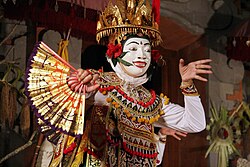 Gendang Beleq dance performance | |
| Origin | Indonesia |
|---|---|
| Gendang Beleq (dance) |
|---|
|
| Burma |
| Cambodia |
| Indonesia |
|
| Laos |
| Malaysia |
| Philippines |
| Singapore |
| Thailand |
|
| Vietnam |
Gendang Beleq dance is a sacred folk dance tradition of the Sasak people [1] of Lombok, West Nusa Tenggara, Indonesia. [2] This dance performance is usually accompanied by big drums, called gendang beleq . [3]
Contents
Gendang beleq can be performed during life-cycle ceremonies, such as celebration of birth, circumcision, wedding and funeral. It can also be performed in a ceremony to invoke rainfall or in a celebration for national holidays. [4]








